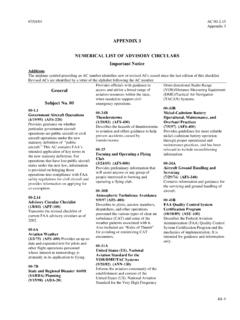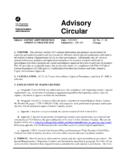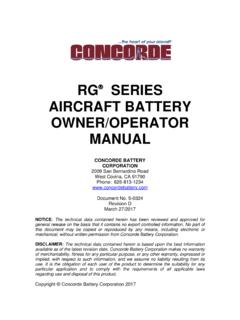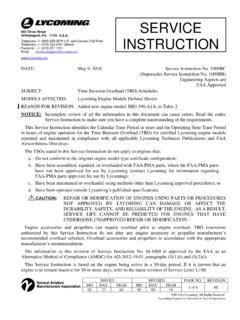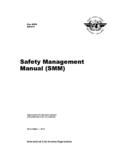Transcription of AC 00-1.1A - Public Aircraft Operations
1 Department of Transportation Federal Aviation Administration advisory circular Subject: Public Aircraft Operations Date: 2/12/14 Initiated by: AFS-800 AC No: Change: 1. PURPOSE. This advisory circular (AC) provides information to assist in determining whether government or government-contracted Aircraft Operations conducted within the territory of the United States are Public or civil Aircraft Operations under the statutory definition of Public Aircraft , in Title 49 of the United States Code (49 ) 40102(a)(41) and 40125 (the statute). Additionally, this AC contains Federal Aviation Administration (FAA) policy pertaining to civil Aircraft operators that provide contract support to government entities. The intent of this material is to better define the responsibilities of the parties to these contracts. This AC is not mandatory and does not constitute a regulation. Nothing in this AC changes the legal requirement for Public Aircraft operators to comply with the statute.
2 2. APPLICABILITY. This AC provides information for any person who engages in Public Aircraft Operations (PAO) as defined by the statute. 3. CANCELLATIONS. This AC cancels AC , Government Aircraft Operations , dated April 19, 1995. 4. RELATED REGULATIONS: Title 14 of the Code of Federal Regulations (14 CFR); and Title 49 40102(a)(41) and 40125. 5. RELATED MATERIAL (current editions). AC 120-16, Air Carrier Maintenance Programs. 6. BACKGROUND. a. Statutory Criteria. PAO are limited by the statute to certain government Operations within airspace. Although these Operations must continue to comply with certain general operating rules, including those applicable to all Aircraft in the National Airspace System (NAS), other civil certification and safety oversight regulations do not apply to these Operations . Accordingly, most aspects of PAO are not subject to FAA oversight. b.
3 Considerations. Whether an operation qualifies as a PAO is determined on a flight-by-flight basis, under the terms of the statute. The considerations when determining PAO are Aircraft ownership, the operator, the purpose of the flight, and the persons on board the Aircraft . AC 2/12/14 c. Civil Aircraft Operation. Any operation that does not meet the statutory criteria for a PAO is a civil Aircraft operation and must be conducted in accordance with all FAA regulations applicable to the operation. The Public Aircraft statute sets forth criteria that determine whether a government operation qualifies as a PAO. d. Statutory Provisions. Title 49 40102(a)(41) provides the definition of Public Aircraft and 40125 provides the qualifications for Public Aircraft status. These statutory provisions provide the legal basis for operation of Public Aircraft in the United States (see Appendix 1, Public Aircraft Statute).
4 The FAA recognizes that these statutory provisions may be difficult to apply to Aircraft Operations conducted by civil contractors for government entities. This AC reiterates the FAA s policy for civil operators contracting with government entities and defines the responsibilities of the parties affected by these contracts. Unmanned Aircraft systems (UAS) may qualify for a PAO certificate of authorization (COA) or waiver under the terms of the statute and other requirements for PAO UAS operating in the NAS. UAS operators should contact the Unmanned Aircraft Systems Integration Office (AFS-80) regarding specific questions on Operations of UAS as Public Aircraft that may not be addressed in this document (see Appendix 2). e. Format. We are presenting the material in this AC in the format of frequently asked questions regarding PAO. We are also including some simplified flow charts to aid in determining whether certain Operations qualify as PAO.
5 The flow charts are intended to be used to aid government entities to determine whether certain flights they operate qualify for operation as PAO under the statute. 7. Public Aircraft Operations , GENERAL. a. What Aircraft are Considered Public Aircraft ? Public Aircraft are defined in 49 40102(a)(41) (see Appendix 1). b. Are All Operations by Government Entities PAO? Not necessarily; t he statute restricts PAO to those that do not have a commercial purpose and, where applicable, to flights with certain persons on board. A government entity may unintentionally conduct civil Operations that would be subject to the regulations in 14 CFR. All government entities are advised to become acquainted with the basics of the statutory requirements. c. What Circumstances Enter Into the Determination of a PAO? The statute includes provisions on Aircraft ownership, the entity operating the Aircraft , the persons on board, and the purpose of the flight to determine whether Operations are Public or civil.
6 At no time may a Public operation have a commercial purpose. Reimbursement for PAO is strictly limited to one set of circumstances defined in the statute (refer to 49 40125(a)(1)), though certain military Operations under Title 10 may involve other statutory considerations. It is important to note that the commercial purpose provision of the statute does not prohibit government entities from contracting civil operators for the purposes of conducting PAO. The provision prohibits reimbursement for the government entity, but does not prohibit contractors from being paid for conducting eligible PAO (see paragraph 10(c) below.). Page 2 Par 6 2/12/14 AC d. Are All Operations by the Armed Forces PAO? Not necessarily; t he military is covered under a separate paragraph of the statute (49 .C . 40125(c)) to include much of its routine operation. Separate provisions in that paragraph determine the status of certain Operations performed by civil contractors that require a designation by the Secretary of Defense.
7 E. What Oversight of PAO Does the FAA Have? The FAA has limited oversight of PAO, though such Operations must continue to comply with the regulations applicable to all Aircraft operating in the NAS. The government entity conducting the PAO is responsible for oversight of the operation, including Aircraft airworthiness and any operational requirements imposed by the government entity. The government agency contracting for the service assumes the responsibility for oversight of a PAO. f. Does the FAA Prescribe Regulations for PAO? No, the FAA has no regulatory authority over PAO other than those requirements that apply to all Aircraft operating in the NAS. g. Which Regulations in 14 CFR Do Not Apply to PAO? In general, regulations that include the term civil Aircraft in their applicability do not apply to PAO ( , part 91, , Civil Aircraft Airworthiness). h. Can I Conduct a PAO Outside of the United States?
8 No, Public Aircraft status exists only within airspace. Once an Aircraft leaves airspace, it loses its PAO status and is either civil or State (including military), depending on its official designation. The FAA does not have the authority to issue State or military Aircraft designations. Individual states and local governments do not have the authority to declare their Operations to be State Operations . Without an official Government designation, all Aircraft outside airspace are considered civil. i. Can I Carry Passengers on an Aircraft That is Conducting a PAO? All persons carried on board must be crewmembers or meet the statutory definition of qualified noncrewmember (refer to A ppendix 1, 49 40125(a)(3)). Carriage of a person other than a crewmember or a qualified noncrewmember makes a flight civil under the terms of the statute. It is important to note that a qualified noncrewmember is someone whose presence is required to perform the governmental function associated with the flight; providing air transportation is not a governmental function (except as provided for in 49 40125(c)).
9 J. What Constitutes a Governmental Function? The statute provides several examples of governmental functions in 49 40125(a)(2). This list is not inclusive and other governmental functions may exist. Functions not listed should not be presumed to be acceptable; contact the International Law, Legislation, and Regulations Division (AGC-200) regarding a legal interpretation to identify additional functions. k. Can a Government Entity Qualify for a Civil Operating Certificate? Yes, provided the government entity requires a civil operating certificate to conduct proposed Operations that cannot be conducted as a PAO. Government entities must follow the same application and certification processes and comply with the same regulatory requirements as all other civil applicants. The FAA advises all government entities with a civil operating certificate to establish a clear process for determining whether a flight is a PAO or is being conducted under its civil operating certificate.
10 Par 7 Page 3 AC 2/12/14 l. If I Am a Government Entity with an Aircraft that Does Not Have a Civil Airworthiness Certificate, May I Use it to Conduct a PAO? Yes, however, Aircraft that do not have a Civil Airworthiness Certificate may not operate as a civil Aircraft . Government entities are cautioned to become familiar with the requirements for PAO status so that they do not unintentionally conduct civil Operations with these Aircraft . For example, a government entity using surplus military Aircraft without civil airworthiness certificates could not receive compensation for any Operations with those Aircraft ( , could not operate them as civil Aircraft under any part of 14 CFR). 8. FAA POLICY FOR CONTRACTING CIVIL Aircraft OPERATORS. To clarify FAA oversight of certain contracted civil Aircraft operators, on March 23, 2011, the FAA published its Notice of Policy Regarding Civil Aircraft Operators Providing Contract Support to Government Entities ( Public Aircraft Operations ) (76 FR 16349).










